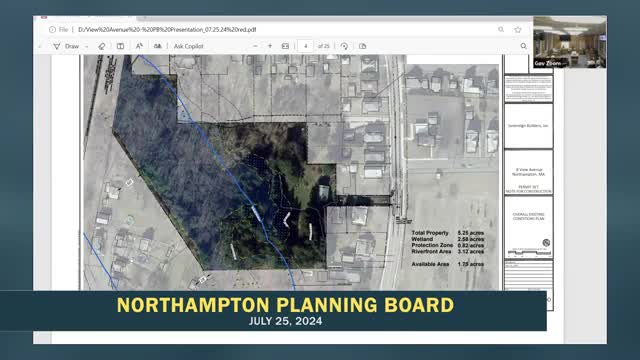City debates tree protection amid housing project plans
July 26, 2024 | Northampton City, Hampshire County, Massachusetts

This article was created by AI summarizing key points discussed. AI makes mistakes, so for full details and context, please refer to the video of the full meeting. Please report any errors so we can fix them. Report an error »

In a recent government meeting, officials discussed the implications of a proposed development project that involves tree protection and sidewalk construction. The conversation centered around ensuring compliance with the Department of Public Works (DPW) design standards, particularly regarding waterline connectivity and the need for final designs to be approved before any construction begins.
A significant point of contention was the impact of the project on local trees, with suggestions made to collaborate with an arborist to minimize potential damage. Board members debated the width of the proposed sidewalk, considering a reduction from the standard five feet to four feet to better accommodate tree roots while still meeting accessibility requirements. The idea of striping the street as an alternative for pedestrian safety was also mentioned, but many emphasized the importance of preserving the trees.
The discussion highlighted the balance between urban development and environmental preservation, with one member noting the potential increase in city taxes by approximately $110,000 as a result of the project. This financial benefit was weighed against the ecological impact, particularly concerning the preservation of wetlands and tree canopies.
Officials acknowledged the need for further assessments by the Conservation Commission to ensure that wetlands are safeguarded. The meeting underscored the ongoing challenge of accommodating housing demands in a desirable area while maintaining environmental integrity, reflecting broader trends in urban planning and community development.
A significant point of contention was the impact of the project on local trees, with suggestions made to collaborate with an arborist to minimize potential damage. Board members debated the width of the proposed sidewalk, considering a reduction from the standard five feet to four feet to better accommodate tree roots while still meeting accessibility requirements. The idea of striping the street as an alternative for pedestrian safety was also mentioned, but many emphasized the importance of preserving the trees.
The discussion highlighted the balance between urban development and environmental preservation, with one member noting the potential increase in city taxes by approximately $110,000 as a result of the project. This financial benefit was weighed against the ecological impact, particularly concerning the preservation of wetlands and tree canopies.
Officials acknowledged the need for further assessments by the Conservation Commission to ensure that wetlands are safeguarded. The meeting underscored the ongoing challenge of accommodating housing demands in a desirable area while maintaining environmental integrity, reflecting broader trends in urban planning and community development.
View full meeting
This article is based on a recent meeting—watch the full video and explore the complete transcript for deeper insights into the discussion.
View full meeting
